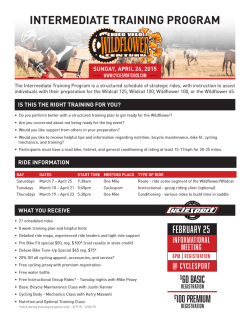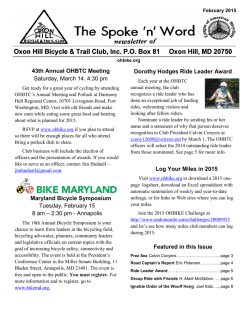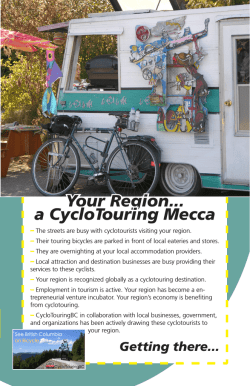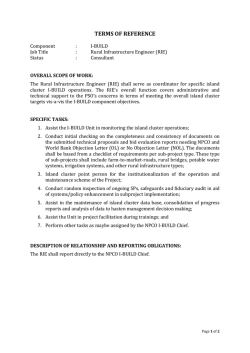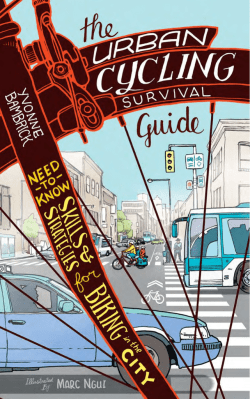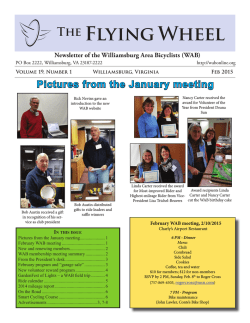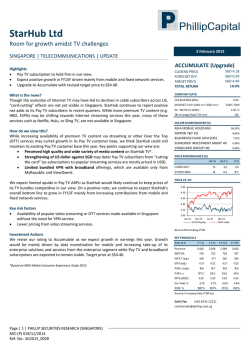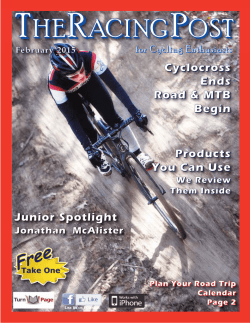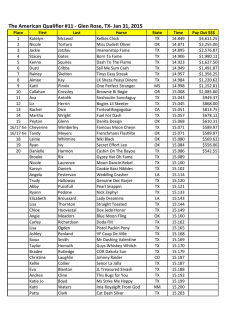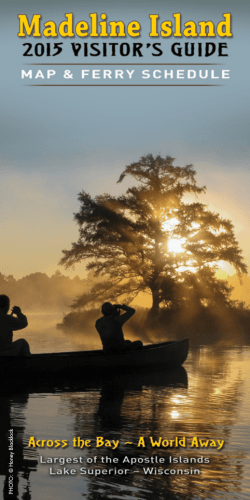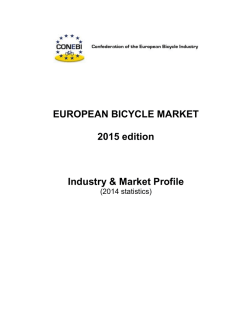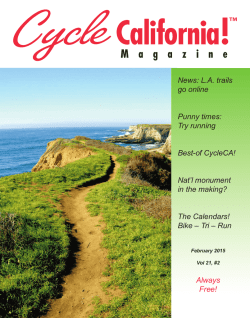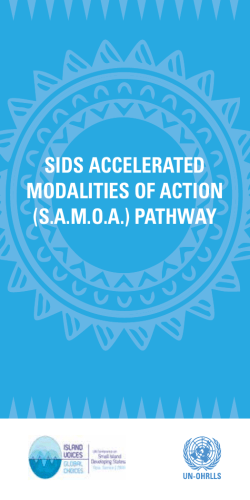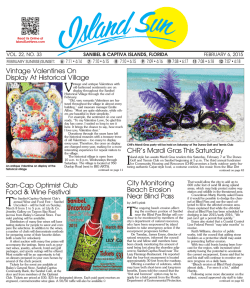
Newsletter - Phillip Island BUGS
Phillip Island BUG (Bicycle Users Group)
Newsletter
President: Don Turner
www.islandbug.info
Secretary: Ron Hateley
1st February 2015
Issue 02/15
Phillip Island Cyclists
Phillip Island
Chocolate Factory
Stupidity Hill, Rhyll
As most are aware, members of the Phillip Island Cyclists meet of a
morning at IGA. This is known by many visitors to the Island and
during the holiday season the numbers gathering at IGA are quite
significant. In fact it has been necessary to split the ride into groups to
minimise road congestion . The above photo shows what happens
when one group catches up with the other. Geoff Moed of the faster
group can be seen leading up the hill at Rhyll. The hill is not really
known as “Stupidity Hill” but you do have to be “stupid” to ride up it.
You may notice that Geoff is wearing his BUG ride shirt
I am not aware of numbers on this ride but you can see considerable
congestion in mid bunch and the tail goes for quite some distance
down the road
I found the above photo on the Phillip Island Cyclists’ page on
Facebook, having been posted by Owen Bentley. I also sent a copy to
The Advertiser and it did appear on the back page on Wed 14th Jan.
Phillip Island BUG (Bicycle Users Group)
Page 2
Start to the day
Phillip Island
Chocolate Factory
Members of the Phillip Island Cyclists preparing to mount and
follow the Tour Down Under in Adelaide recently
However, like most cyclists you must start and end the day with a
coffee stop
The final coffee stop at the end of the tour
Phillip Island BUG (Bicycle Users Group)
Page 3
Sharing the Roads - South Australian Review
The Tour Down Under is a celebration of cycling that both
showcases our beautiful city and State to the world and promotes
active and healthy lifestyles.
As the popularity of the Tour has risen, so too has cycling in our
community.
But along with that popularity has come much public debate, which
has pitted cyclists against drivers. This overlooks the fact that
cyclists also drive cars and many motorists ride bikes.
Phillip Island
Chocolate Factory
Changing this way of thinking is an issue not just for government
but for every South Australian.
That’s why I established the Citizens’ Jury. I wanted the judgment
of everyday people about issues that affect all South Australians.
I am very pleased to say that the Jury has developed ideas that, I
have no doubt, will make our roads safer.
On behalf of every South Australian, I would like to thank each
juror for the significant role they have played.
I would also like to thank the many organisations and individuals
who supported the Jury’s deliberations.
Jay Weatherill
Premier of South Australia
What is a Citizens’ Jury?
A Citizens’ Jury is a small randomly-selected group of citizens
which considers complex community issues, hears expert
information and a range of views, carefully considers all
perspectives and makes recommendations to Government about
resolving those issues.
The Jury’s dilemma
This Citizens’ Jury tackled the contentious issue of motorists and
cyclists sharing our roads.
South Australia has a strong culture of motoring and there is a
growing movement towards encouraging more people to cycle.
The Jury was presented with the following topic:
Motorists and cyclists will always be using our roads. What can
we trial to ensure they share the roads safely?
Phillip Island BUG (Bicycle Users Group)
Page 4
South Australian Government response to the
Citizens’ Jury report “ Sharing the roads safely”
Summarised Recommendation
1
Legislate to define overtaking space between a vehicle and a
Response
Support
cyclist as one metre
Phillip Island
Chocolate Factory
2
Trial an integrated safe cycling and road rule education
Support
3.1
Change the driver’s licence process – combine two
Support
3.2
Change the driver’s licence process – amend the learner’s
Support
3.3
A trial focussed on informing via flash screen
Support
3.4
Trial opportunities to update road rules knowledge
Support
4
Legislate to allow cycling on footpaths for all ages
Support
5.1
Make cycle paths continuous
Support
5.2
Maintain bike paths regularly
Support
5.3
Apply a realistic standard width for cycle lanes
Support
5.4
Plan for cycle paths and lanes in future roads
Support
5.5
Connect existing greenways and bike tracks
Support
5.6
Establish new greenways and bike tracks
Support
5.7
Construct bike cages at public transport interchanges
Support
5.8
Trial the installation of bike racks on the front of buses
Investigate
5.9
Install green boxes at major intersections
Support
6
Conduct field trials of cycle lane markings
Support
7
Conduct trials of reduced speed and altered traffic flow
Investigate
8
Collaborate to deliver a road safety campaign
Support
9
Establish an annual ‘safe cycling environment’ award for
Support
10
Continue and enhance initiatives relating to visibility
Investigate
The South Australian Government is the third government to
recommend “a metre matters”. The Amy Gillet Foundation has also
been instrumental in the establishing of the above
recommendations.
Phillip Island BUG (Bicycle Users Group)
Page 5
BUG News
Super Tuesday
The BUG has accepted a commitment to participate in the Super
Tuesday count on Tuesday 2nd March. The location chosen by the
Shire will be Kilcunda and about 100metres east of the carpark and
across the old railway bridge. You will know the spot as there is a
path up from the car park and a path to the surf beach. It will be an
early morning job. We will be calling for volunteers in the near
future
Phillip Island
Chocolate Factory
MTB Event at Foster
The BUG has also been requested to assist as marshalls at a MTB
event at Foster on Sunday 22nd February. At this moment very little
detail is known other than they anticipate around 60 riders plus will
also run a kids’ event.
When information comes available we will be calling for volunteers
and also how it will affect the planned ride for that day.
Great Ocean Road
Like all plans, something must go wrong in the planning stages to
make life that more difficult for the organisers. The Great Ocean
Road ride is no exception and we have hit a couple of stumbling
blocks along the way.
The first of these was Ron taking a couple of falls requiring an
extended stay in hospital in WA. We thought that was bad enough
but on arrival back home he took a turn for the worse and was
eventually diagnosed with “golden staph”. All being well, treatment
for this should be completed by last Friday.
Alan Morgan has had to withdraw from the ride due having been
diagnosed with rheumatoid arthritis (ouch) and recently his
specialist has prescribed medication which he is hopeful will ease
the pain but it takes 8 weeks to take full effect. Consequently riding
the bike is out of the question at this time – not completely as Alan
and Ron have got together and sometimes of an afternoon they can
be seen riding around Silverleaves
The original plan when Alan was to ride was that Joy would drive
their 4WD and follow the group as a sag wagon. Alan and Joy have
now cancelled out of the tour
The plan now is that Ron will drive Don’s SUV with the trailer and
that will be the sag wagon and carry the bags etc from overnight
stop to overnight stop.
Phillip Island BUG (Bicycle Users Group)
Page 6
Phillip Island Integrated Road Transport Study
A meeting of interested parties was held recently to form a formal
group to liaise with the Bass Coast Shire and VicRoads for
improvements to the various transport systems and pathways on
Phillip island and San Remo.
The BUG has two representatives on the committee which was
formed at the meeting. Our President, Don Turner will be Vice
Chairman and Norm Hall is an ordinary member of the committee.
The next meeting of the IRTS group will take place on 11th March.
If you have something you wish to raise then contact either Don or
Norm but please remember it is very early days and the committee
is still “feeling it’s feet”
Phillip Island
Chocolate Factory
In Time of Need
The workshop area of my garage
A short time back a member of the BUG was cycling in the Surf
Beach area and experienced problems so decided to walk home to
Cowes – not an easy task when wearing cycling shoes with cleats.
He managed to walk right past my driveway. If he knocked on the
door I may have been able assist in some form or other, not the least
to give him a lift.
For those passing by, I normally have a number of spare tyres of
varying sizes, 6 different size tubes, an air compressor and a range
of spare parts. Why hobble past on cleats when a simple solution is
nearby.
I am not the only cyclist with a range of spare bits, just imagine
what Ron has at home. Take note of where members live and in
times of difficulty do not hesitate to knock on the door – that’s what
friends are for. As I said earlier they may not be able to fix it but
can offer a lift home rather than hobble home.
Phillip Island BUG (Bicycle Users Group)
Page 7
Queensland Government Inquiry into Cycling Issues
Benefits of cycling – individual & community
Phillip Island
Chocolate Factory
There are numerous, well-documented benefits of cycling including
health, social, economic and environmental benefits including:
cycling is a low impact activity and one of the safest ways to
exercise without risk of overexertion or strain to muscles and joints
anxiety, stress and depression are all alleviated, partly due to
the physical activity itself, but also due to the pleasure and
satisfaction of riding a bicycle
cycling has additional wider public benefits such as lowering
road and traffic congestion
encouraging active transport for adults and children improves
physical activity levels and reduces sedentary time
cycling 10 kilometres each way to work reduces greenhouse gas
emissions (1500 kg/year)
the community saves 60 cents per kilometre for every car trip
replaced by a bicycle ride
less car parks required - up to 20 bicycles can be stored in the
space required for one car
bicycles offer door-to-door service and are often quicker than
cars over short distances up to five kilometres
cycling offers a cheaper form of transport for those who are
socially disadvantaged and less likely to own a car. 7
The Cycling Promotion Fund provides the following assessment of
the increasing reliance on the motor vehicle as the only legitimate
mode of transport:
It is now increasingly clear that excessive car use is having
negative economic repercussions.
The soaring cost of oil, spiralling rates of obesity and congestion as
well as mounting concern over climate change reinforces the urgent
need to assess our current transport behaviour and seek practical,
sustainable alternatives.8
The following estimated costs are provided as evidence:
premature deaths due to motor vehicle air pollution – cost
between $1.1 and $2.6 billion
congestion costs in our capital cities is estimated to soar to $20.4
billion by 2020
direct gross cost of physical inactivity to the Australian health
budget is $1.49 billion
greenhouse gas saving of 8 million/year (at $40/tonne) of those
cycling to work in 2006.
Phillip Island BUG (Bicycle Users Group)
Page 8
A Quick History of Bicycles
(copied from Pedalling History Bicycle Museum)
The Walking Machine
In 1817 Baron von Drais invented a walking machine that would help
him get around the royal gardens faster: two same-size in-line wheels,
the front one steerable, mounted in a frame which you straddled. The
device was propelled by pushing your feet against the ground, thus
rolling yourself and the device forward in a sort of gliding walk. The
machine became known as the Draisienne or hobby horse. It was made
entirely of wood. This enjoyed a short lived popularity as a fad, not
being practical for transportation in any other place than a well
maintained pathway such as in a park or garden.
The Velocipede or Boneshaker
The next appearance of a two-wheeled riding machine was in 1865,
when pedals were applied directly to the front wheel. This machine
was known as the velocipede ("fast foot"), but was popularly known
as the bone shaker, since it was also made entirely of wood, then
later with metal tires, and the combination of these with the
cobblestone roads of the day made for an extremely uncomfortable
ride. They also became a fad, and indoor riding academies, similar
to roller rinks, could be found in large cities.
The High Wheel Bicycle
In 1870 the first all metal machine appeared. (Previous to this metallurgy
was not advanced enough to provide metal which was strong enough to
make small, light parts out of.) The pedals were still atttached directly to
the front wheel with no freewheeling mechanism. Solid rubber tires and the
long spokes of the large front wheel provided a much smoother ride than its
predecessor. The front wheels became larger and larger as makers realized
that the larger the wheel, the farther you could travel with one rotation of
the pedals. You would purchase a wheel as large as your leg length would
allow. This machine was the first one to be called a bicycle ("two
wheel"). These bicycles enjoyed a great popularity among young men of
means (they cost an average worker six month's pay), with the hey-day
being the decade of the 1880s.Because the rider sat so high above the
center of gravity, if the front wheel was stopped by a stone or rut in the
road, or the sudden emergence of a dog, the entire apparatus rotated
forward on its front axle, and the rider, with his legs trapped under the
handlebars, was dropped unceremoniously on his head. Thus the term
"taking a header" came into being.
Phillip Island BUG (Bicycle Users Group)
Page 9
The High Wheel Tricycle
While the men were risking their necks on the high wheels, ladies,
confined to their long skirts and corsets, could take a spin around
the park on an adult tricycle. These machines also afforded more
dignity to gentlemen such as doctors and clergymen. Many
mechanical innovations now associated with the automobile were
originally invented for tricycles. Rack and pinion steering, the
differential, and band brakes, to name a few!
The High Wheel Safety
Improvements to the design began to be seen, many with the
small wheel in the front to eliminate the tipping-forward
problem. One model was promoted by its manufacturer by being
ridden down the front steps of the capitol building in
Washington, DC. These designs became known as high-wheel
safety bicycles. Since the older high-wheel designs had been
known simply as bicycles, they were now referred to as
"ordinary bicycles" in comparison with the new-fangled designs,
and then simply as "ordinaries."
The Hard-Tired Safety
The further improvement of metallurgy sparked the next innovation,
or rather return to previous design. With metal that was now strong
enough to make a fine chain and sprocket small and light enough for
a human being to power, the next design was a return to the original
configuration of two same-size wheels, only now, instead of just one
wheel circumference for every pedal turn, you could, through the gear
ratios, have a speed the same as the huge high-wheel. The bicycles
still had the hard rubber tires, and in the absence of the long, shockabsorbing spokes, the ride they provided was much more
uncomfortable than any of the high-wheel designs. Many of these bicycles of 100 years ago had front
and/or rear suspensions. These designs competed with each other, your choice being the high-wheel's
comfort or the safety's safety, but the next innovation tolled the death of the high-wheel design.
The Pneumatic-Tired Safety
The pneumatic tire was first applied to the bicycle by an
Irish veterinarian who was trying to give his young son a
more comfortable ride on his tricycle. This inventive young
doctor's name was Dunlop. Sound familar? Now that
comfort and safety could be had in the same package, and
that package was getting cheaper as manufacturing methods
improved, everyone clamored to ride the bicycle. This 1898
Yale uses a shaft drive to dispense with the dirty chain.
Phillip Island BUG (Bicycle Users Group)
Page 10
The bicycle was what made the Gay Ninties gay. It was a practical investment for the working
man as transportation, and gave him a much greater flexibility for leisure. Ladies, heretofore
consigned to riding the heavy adult size tricycles that were only practical for taking a turn around
the park, now could ride a much more versatile machine and still keep their legs covered with long
skirts. The bicycle craze killed the bustle and the corset, instituted "common-sense dressing" for
women and increased their mobility considerably. In 1896 Susan B. Anthony said that "the bicycle
has done more for the emancipation of women than anything else in the world."
Bicycling was so popular in the 1880s and 1890s that cyclists formed the League of American
Wheelman (still in existence and now called the League of American Bicyclists). The League
lobbied for better roads, literally paving the road for the automobile.
The Kid's Bike
Introduced just after the First World War by several
manufacturers, such as Mead, Sears Roebuck, and
Montgomery Ward, to revitalize the bike industry (Schwinn
made its big splash slightly later), these designs, now called
"classic", featured automobile and motorcyle elements to
appeal to kids who, presumably, would rather have a motor.
If ever a bike needed a motor, this was it. These bikes
evolved into the most glamorous, fabulous, ostentatious,
heavy designs ever. It is unbelievable today that 14-yearold kids could do the tricks that we did on these 65 pound
machines! They were built into the middle '50s, by which time they had taken on design elements
of jet aircraft and even rockets. By the '60s, they were becoming leaner and simpler.
The Current Scene
Pedaling History has on display even the recent history of the bicycle in America that we are more
familiar with: the "English 3-speed" of the '50s through the '70s, the 10-speed derailleur bikes
which were popular in the '70s (the derailleur had been invented before the turn of the century and
had been in more-or-less common use in Europe since), and of course the mountain bike of right
now. There are also many oddball designs that never quite made it, including the Ingo (you have
to see it to believe it!)
If you'd like to know more about these fascinating machines, you may be interested in the book
Collecting and Restoring Antique Bicycles, by G. Donald Adams.
You can also contact Pedaling History at [email protected]
Phillip Island BUG (Bicycle Users Group)
Page 11
Ride Calendar for February 2015
Sun 1st Feb
Wed 4th Feb
Sun 8th Feb
Wed 11th Feb
Phillip Island
Chocolate Factory
Sun 15th Feb
Wed 18th Feb
Sun 22nd Feb
Wed 25th Feb
Fri 27th Feb
Sun 1st Mar
Start: A Maze’N Things 10.00am
Casual Sunday ride to Big Wave for coffee
Start: A Maze’N Things 10.00am
Woolamai Estate Tour
Coffee at Burnt Toast
Road bike 30k
Start: Bass Opp Shop 10.00am
Bass, Glen Forbes, Corinella, Bass
Coffee at Corinella
Road bike 37k
Start: A Maze’N Things 10.00am
Tour de Cowes West
Coffee at OzBikes
Road bike 21k
Start: A Maze’N Things 10.00am
Casual Sunday ride to Oz Bikes for coffee
Start: A Maze’N Things 10.00am
Tour de Newhaven
Coffee at Big Wave
Road bike 22k
Start: Wonthaggi Park 10.00am
Wonthaggi, Lynnes Rd, Inverloch, Cape Paterson
Coffee at Bakery Inverloch
Road bike 39k
Start: A Maze’N Things 10.00am
Rhyll Rd, Harbison Rd, Oswin Roberts,
Shearwater Estate, Silverleaves, Bike Shop
Coffee at Oz Bikes
Off road bike 20k
Avalon Air Display
(don’t try to get any common sense out of me
for the next few days)
Start: A Maze’N Things 10.00am
Casual Sunday ride to Big Wave for coffee and
debrief on Avalon Air Display
© Copyright 2024
